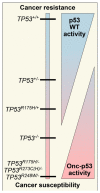The consequence of oncomorphic TP53 mutations in ovarian cancer
- PMID: 24065105
- PMCID: PMC3794832
- DOI: 10.3390/ijms140919257
The consequence of oncomorphic TP53 mutations in ovarian cancer
Abstract
Ovarian cancer is the most lethal gynecological malignancy, with an alarmingly poor prognosis attributed to late detection and chemoresistance. Initially, most tumors respond to chemotherapy but eventually relapse due to the development of drug resistance. Currently, there are no biological markers that can be used to predict patient response to chemotherapy. However, it is clear that mutations in the tumor suppressor gene TP53, which occur in 96% of serous ovarian tumors, alter the core molecular pathways involved in drug response. One subtype of TP53 mutations, widely termed gain-of-function (GOF) mutations, surprisingly converts this protein from a tumor suppressor to an oncogene. We term the resulting change an oncomorphism. In this review, we discuss particular TP53 mutations, including known oncomorphic properties of the resulting mutant p53 proteins. For example, several different oncomorphic mutations have been reported, but each mutation acts in a distinct manner and has a different effect on tumor progression and chemoresistance. An understanding of the pathological pathways altered by each mutation is necessary in order to design appropriate drug interventions for patients suffering from this deadly disease.
Figures



Similar articles
-
TP53 oncomorphic mutations predict resistance to platinum‑ and taxane‑based standard chemotherapy in patients diagnosed with advanced serous ovarian carcinoma.Int J Oncol. 2015 Feb;46(2):607-18. doi: 10.3892/ijo.2014.2747. Epub 2014 Nov 11. Int J Oncol. 2015. PMID: 25385265 Free PMC article.
-
Oncomorphic TP53 Mutations in Gynecologic Cancers Lose the Normal Protein:Protein Interactions with the microRNA Microprocessing Complex.J Cancer Ther. 2014 Jun 1;5(6):506-516. doi: 10.4236/jct.2014.56058. J Cancer Ther. 2014. PMID: 25339994 Free PMC article.
-
Clinical relevance of gain-of-function mutations of p53 in high-grade serous ovarian carcinoma.PLoS One. 2013 Aug 13;8(8):e72609. doi: 10.1371/journal.pone.0072609. eCollection 2013. PLoS One. 2013. PMID: 23967324 Free PMC article.
-
TP53 and ovarian cancer.Hum Mutat. 2003 Mar;21(3):285-91. doi: 10.1002/humu.10181. Hum Mutat. 2003. PMID: 12619114 Review.
-
The Many Uses of p53 Immunohistochemistry in Gynecological Pathology: Proceedings of the ISGyP Companion Society Session at the 2020 USCAP Annual9 Meeting.Int J Gynecol Pathol. 2021 Jan;40(1):32-40. doi: 10.1097/PGP.0000000000000725. Int J Gynecol Pathol. 2021. PMID: 33290354 Review.
Cited by
-
DNA Repair Genes as Drug Candidates for Early Breast Cancer Onset in Latin America: A Systematic Review.Int J Mol Sci. 2021 Dec 2;22(23):13030. doi: 10.3390/ijms222313030. Int J Mol Sci. 2021. PMID: 34884835 Free PMC article.
-
Ovarian BDNF promotes survival, migration, and attachment of tumor precursors originated from p53 mutant fallopian tube epithelial cells.Oncogenesis. 2020 May 29;9(5):55. doi: 10.1038/s41389-020-0243-y. Oncogenesis. 2020. PMID: 32471985 Free PMC article.
-
PAX8 activates a p53-p21-dependent pro-proliferative effect in high grade serous ovarian carcinoma.Oncogene. 2018 Apr;37(17):2213-2224. doi: 10.1038/s41388-017-0040-z. Epub 2018 Jan 30. Oncogene. 2018. PMID: 29379162
-
Ginsenoside Rg3 Inhibits Constitutive Activation of NF-κB Signaling in Human Breast Cancer (MDA-MB-231) Cells: ERK and Akt as Potential Upstream Targets.J Cancer Prev. 2014 Mar;19(1):23-30. doi: 10.15430/jcp.2014.19.1.23. J Cancer Prev. 2014. PMID: 25337569 Free PMC article.
-
Cancer Cells Shuttle Extracellular Vesicles Containing Oncogenic Mutant p53 Proteins to the Tumor Microenvironment.Cancers (Basel). 2021 Jun 15;13(12):2985. doi: 10.3390/cancers13122985. Cancers (Basel). 2021. PMID: 34203762 Free PMC article.
References
-
- McGuire W.P., Hoskins W.J., Brady M.F., Kucera P.R., Partridge E.E., Look K.Y., Clarke-Pearson D.L., Davidson M. Cyclophosphamide and cisplatin compared with paclitaxel and cisplatin in patients with stage III and stage IV ovarian cancer. N. Engl. J. Med. 1996;334:1–6. - PubMed
-
- Weinberg R.A. Tumor suppressor genes. Science. 1991;254:1138–1146. - PubMed
-
- Gadducci A., di Cristofano C., Zavaglia M., Giusti L., Menicagli M., Cosio S., Naccarato A.G., Genazzani A.R., Bevilacqua G., Cavazzana A.O. p53 gene status in patients with advanced serous epithelial ovarian cancer in relation to response to paclitaxel- plus platinum-based chemotherapy and long-term clinical outcome. Anticancer Res. 2006;26:687–693. - PubMed
Publication types
MeSH terms
Substances
Grants and funding
LinkOut - more resources
Full Text Sources
Other Literature Sources
Medical
Research Materials
Miscellaneous

